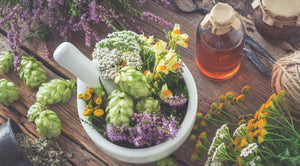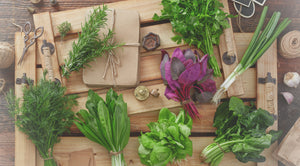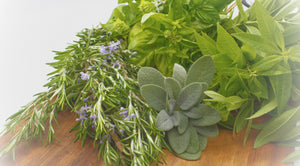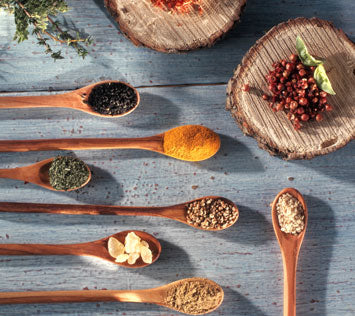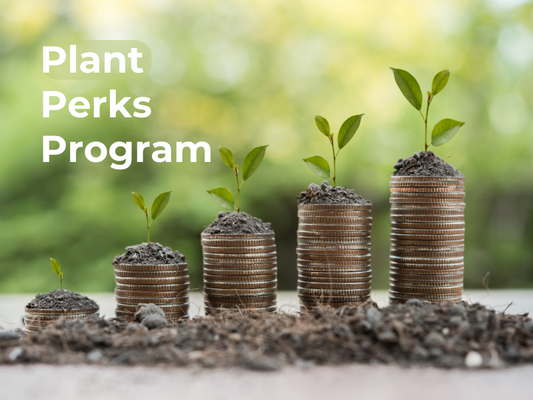Growing Herb Plants Indoors

Helpful Hints & Tips for Growing Herb Plants Indoors
An indoor herb garden allows you to enjoy the flavor and fragrance of fresh herb plants year round. A few pots of herb plants on your kitchen windowsill will always be at hand to add herbal zest to your cooking! Your indoor herb garden could begin with a simple collection of parsley, chives and oregano. Or, you can create imaginative groupings of herb plants for window boxes and hanging baskets. The variety of leaf textures and growth habits present and endless array of possibilities.
We have a wonderful pictograph at the bottom to help summarize this article if you're more of a visual learner!
Potting:
Making sure your plants are in the best pot or container is also crucial to its health. Think about it. When you start to outgrow your shoes, the constriction and tightness is uncomfortable, right? Well, many plants need to be moved to larger containers as they get bigger to give them more adequate space to stretch and grow bigger. The winter is a great time for this as the cool temperatures make the process less stressful on your plants. Give your plants plenty of room to grow and you'll get to enjoy larger and longer lasting results.
Once the stress of the holidays has wound down, indoor gardening can be a terrific therapeutic hobby or, during the holidays if you need an escape from the madness! Gardening year round allows you to enjoy the fruits of your hard work constantly and the calming presence of your indoor plants will bring beauty and fresh aroma to these bleak winter days. Many plants can be easily started indoors during the colder months, for transplant in the spring to an outdoor garden. Try growing your favorite culinary herbs indoors this season to spice things up in your stews and other hearty recipes or just to lend a savory fragrance to your home.
Lighting:
We don't think much about the amount of light outside as it changes from season to season, when we're indoors with electric lights, but this is a major factor for your plants. Especially when time changes towards the end of the year with the shortest amount of daylight. You need to make sure your plants are getting the amount they need. Though probably dormant for the season, your flowering plants tend to like more light than evergreens, cacti and other foliage hardy plants. Whether you unsash your curtains, open the blinds or add additional artificial light, your plants will need a little UV boost through the winter.
Most herb plants need 6-8 hours of direct sun each day. A south, west or east window, unobstructed, should work just fine. There are a few herb plants, such as Mint Plants and Chervil, that will grow in a bright north window. If your plants are getting too leggy and thin, it means that they are not getting enough light and need to be moved into a brighter window. If this isn't possible, then pinch the ends back to encourage bushier growth. Remember to turn your herb plants regularly so that all sides get even exposure to light. Sometimes, herb plants brought into a new environment will suddenly lose their lower leaves. Don't be alarmed by this adjustment; it is your plant's way of dealing with the change in light intensity. The plant is getting rid of leaves which are no longer able to produce enough food and eventually you should see new growth at the growing tips where the light is stronger. Lemon Verbena is especially likely to do this. You can grow herb plants under artificial light sources. Since herb plants require more light than most house plants, position lights as close as possible to the foliage - with in 1" to 2".
Temperature and Humidity:
So, you've moved your little green friends indoors and you figure that should keep them safe from the temperatures, right? Think again. Some plants can be highly sensitive to heat and cold so make sure you aren't placing your Basil plant near a cold, drafty vent or your Lemongrass right beside your wood furnace. Depending on their particular needs, temperature can even speed and slow the growth process for your plants, just like an artificial changing of the seasons. Herb plants are happy in the normal home environment. Problems do arise with herbs indoors when the temperatures are too hot and too dry, especially near a radiator or hot air outlets. If you do have low humidity, you can place your herb plants on a tray of pebbles which is filled with water. Do not immerse the pots in the water, but merely rest them on the pebbles.
Water:
If you're feeling dried out from running your heat on high, chances are that your plants may be, too. Make sure to water them appropriately. Excluding cacti and other succulents, an easy way to tell if your plant needs water is to stick your finger partially into the dirt to test it. If it's bone dry, don't drown it. Water moderately and monitor its progress. If you find that your plants are needing water at alarming rates, check to see where you have them placed. On top of a radiator or next to your fireplace may be too hot for their liking. In general, keep them away from direct sources of heat - don't place on top of a radiator or under a forced air vent. Avoid dry air by either misting your plants regularly or by filling the drainage tray with pebbles and adding water. That will provide a constant source of humidity if needed.
Cleaning and Prevention:
The winter months are a great time to get to know your plants' personalities and to give them a good cleaning. Dust and microscopic debris build up on the plant's leaves which can block sunlight and the plant's pores. In addition, pests can be a problem as their eggs can flourish in the warmth of your home. Try cleaning the tops and bottoms of your plant's leaves with a damp cloth to remove any unwanted buildup that may be hindering your plant from being its healthiest. While you're at it, take a close look for insects and disease. They are pretty easy to spot, either flying or crawling around your plants.
If you spot a problem, it's best to nip an infestation or blight in the bud. In most cases, warm water and a mild soap will do the trick to remove many common pests. For a deeper rooted problem, try an all natural pesticide or fungicide, which can be bought at your local hardware store.
Positioning:
Plants prefer a routine and moving them into your home can be quite an adjustment. To alleviate further disruption to their transition indoors, try to find permanent spots for them when you bring them in. If you can place them in areas where they won't be disturbed by the hustle and bustle of the holidays, pets, kids or just because they're in the way, they'll greatly appreciate it. Moving potted plants too often can really disrupt and unsettle their soil and root structure. Leaving them to settle in and stay sedentary will cause the least amount of stress on them, as leaves, stems, flowers and branches can break, become weak or tear during the moving process. This will also allow the roots to stay strongly grounded, as soil won't be jostled about, loosening the plant's hold.
Fertilizing:
Nutrients in the pot will become exhausted as he plant grows, and they should be replenished with a weak but regular application of soluble fertilizer. Only apply fertilizer when the plants are actually growing, never during periods of slow growth or dormancy. You can also use natural compost teas made of Comfrey or Achillea to help encourage healthy growth, without using synthetic chemicals to "get growing". Most herbs don't need much fertilizer, as too much will decrease the amount of oil the plant produces. This results in a lack of flavor and aroma, which defeats the purpose when growing great herbs!


